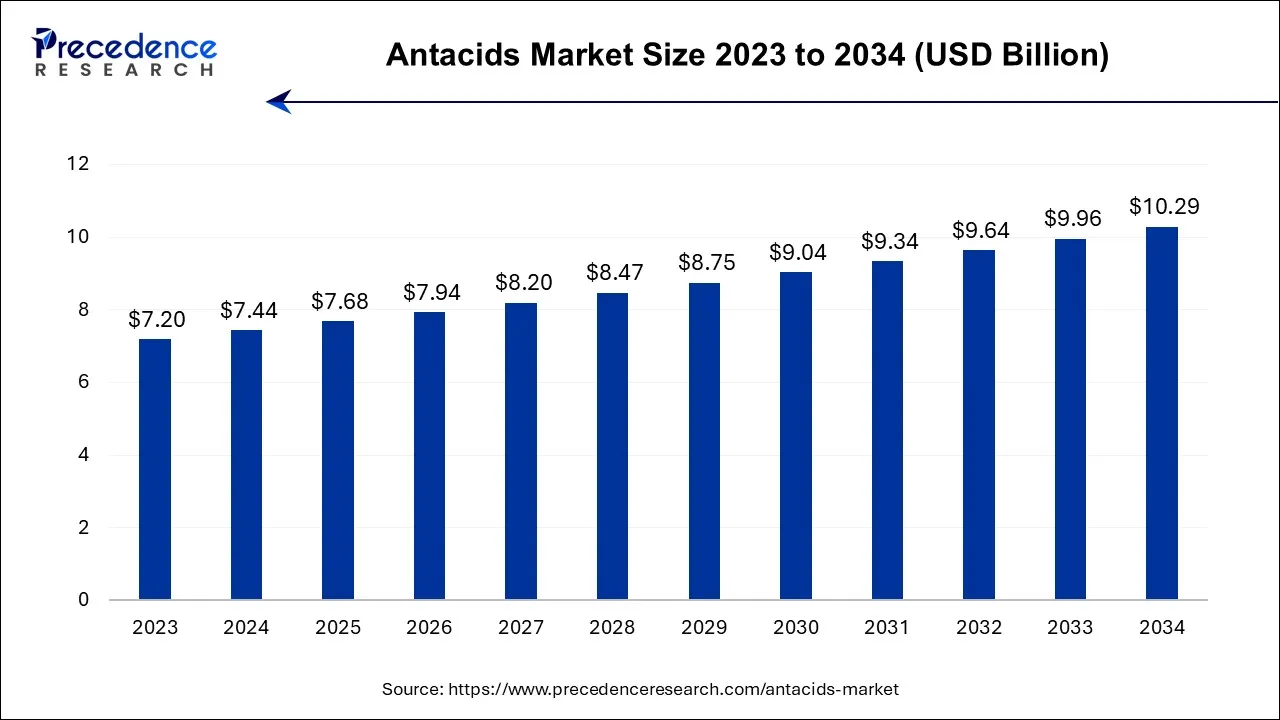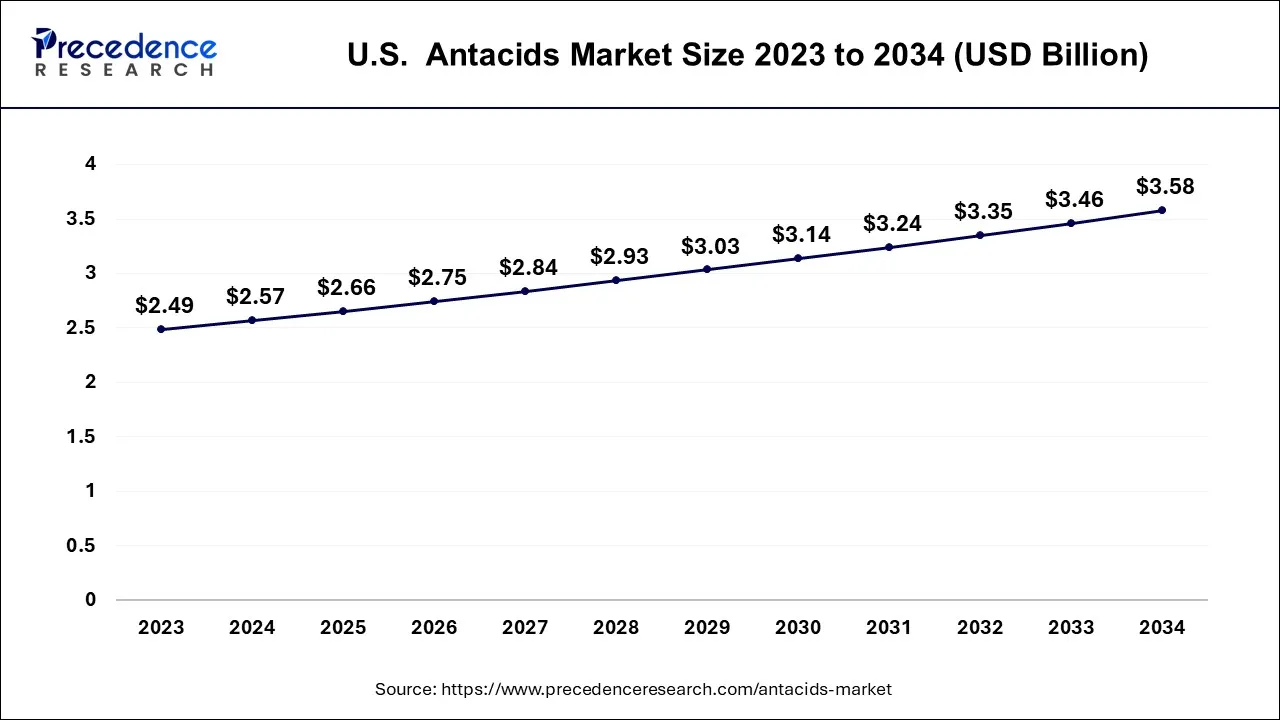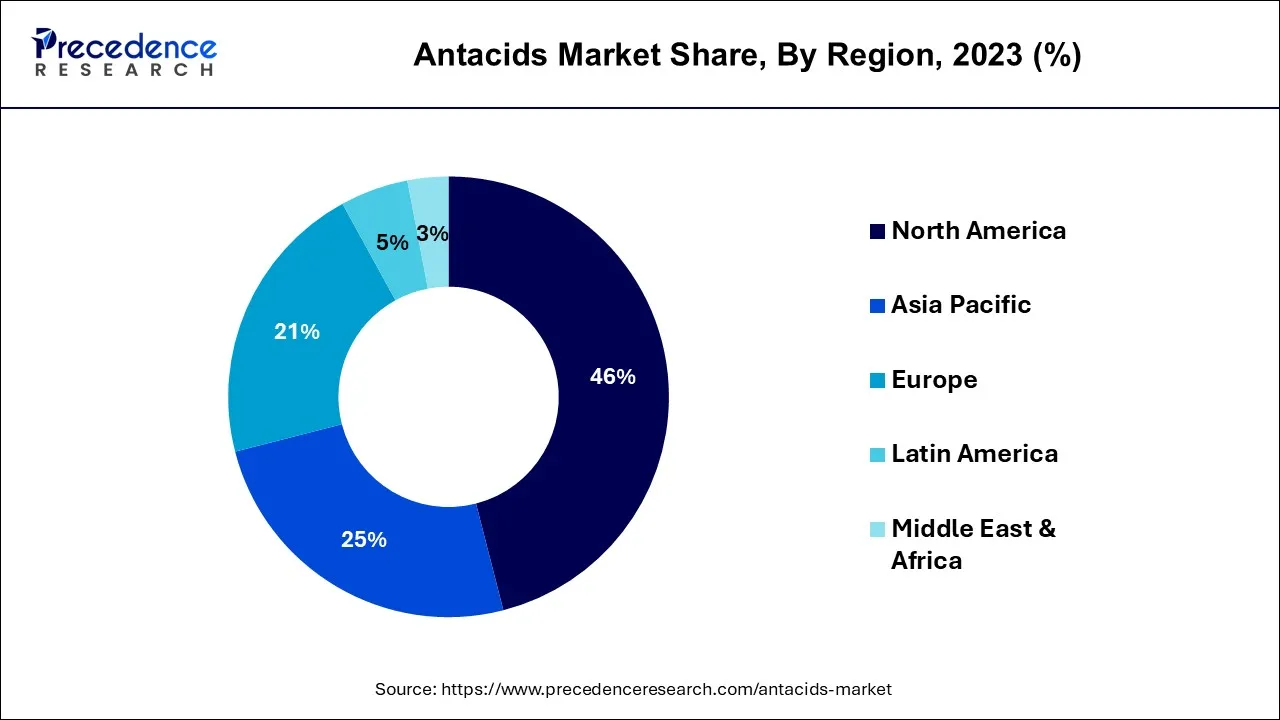The global antacids market size is calculated at USD 7.44 billion in 2024, grew to USD 7.68 billion in 2025, and is predicted to hit around USD 10.29 billion by 2034, poised to grow at a CAGR of 3.3% between 2024 and 2034. The North America antacids market size accounted for USD 3.42 billion in 2024 and is anticipated to grow at the fastest CAGR of 3.35% during the forecast year.
The global antacids market size is expected to be valued at USD 7.44 billion in 2024 and is anticipated to reach around USD 10.29 billion by 2034, expanding at a CAGR of 3.3% over the forecast period from 2024 to 2034.

The U.S. antacids market size accounted for USD 2.57 billion in 2024 and is projected to be worth around USD 3.58 billion by 2034, poised to grow at a CAGR of 3.4% from 2024 to 2034.

North America has held the largest revenue share of 46% in 2023. North America has a significant prevalence of gastrointestinal disorders, including acid reflux and GERD. Modern lifestyles in North America, characterized by stress, dietary habits, and obesity, contribute to the occurrence of digestive issues. Antacids are often sought after for quick relief from symptoms associated with these lifestyle factors. These factors contribute to a steady demand for antacids as a means of symptom relief.
Asia Pacific is estimated to observe the fastest expansion. Rapid urbanization and changing lifestyles in countries across Asia Pacific have led to alterations in dietary habits and an increase in stress, contributing to digestive issues and driving the demand for antacids. The expansion of the middle-class population in several Asia Pacific countries has increased healthcare awareness and affordability, leading to greater access to over-the-counter medications, including antacids.

Europe antacids market is driven by its aging population, and older individuals are more susceptible to digestive issues. This demographic factor can contribute to the demand for antacids as a remedy for age-related gastrointestinal problems. Moreover, the well-developed healthcare infrastructure in many European countries ensures widespread access to medications, including antacids. Also, high levels of consumer awareness regarding over-the-counter medications and self-medication practices contribute to the demand for antacids in Europe.
Antacids are a class of medications that are designed to neutralize excess stomach acid. It is generally used to offer relief from symptoms associated with conditions such as heartburn, acid reflux, and indigestion. Stomach acid is produced naturally in the stomach to help in the digestion of food. However, an overproduction of stomach acid or its reflux into the esophagus may lead to irritation and discomfort. It works by growing the pH (reducing acidity) of the stomach contents. It usually contains compounds that react with stomach acid, creating neutral substances and water. This reaction helps to alleviate symptoms by reducing the acidity in the stomach.
The antacids market includes a variety of over-the-counter (OTC) and prescription medications that are designed to alleviate symptoms associated with excessive stomach acid. The market is driven by various factors such as innovations in antacid formulations, changes in consumer health trends, advancements in medical research, regulatory developments, and the prevalence of conditions that require antacid treatment. Therefore, the antacids market is part of the broader pharmaceutical and healthcare industry, playing a significant role in addressing digestive health issues and improving the quality of life for individuals experiencing symptoms related to excess stomach acid.
| Report Coverage | Details |
| Market Size in 2024 | USD 7.44 Billion |
| Market Size by 2034 | USD 10.29 Billion |
| Growth Rate from 2024 to 2034 | CAGR of 3.3% |
| Largest Market | North America |
| Base Year | 2023 |
| Forecast Period | 2024 to 2034 |
| Segments Covered | By Mechanism of Action, By Formulation Type, and By Distribution Channel |
| Regions Covered | North America, Europe, Asia-Pacific, Latin America, and Middle East & Africa |
Prevalence of gastroesophageal reflux disease (GERD)
Gastroesophageal Reflux Disease (GERD) is a chronic condition marked by the regurgitation of stomach acid into the esophagus, leading to symptoms such as heartburn, and is experiencing a global surge. This escalating occurrence is attributed to evolving lifestyles, including dietary shifts, heightened stress levels, and an increase in obesity rates.
The surge in GERD cases prompts a growing necessity for accessible and effective solutions to alleviate its distressing symptoms. Individuals grappling with frequent heartburn and acid reflux often turn to antacids as a swift remedy. By neutralizing excess stomach acid, antacids offer prompt relief, addressing the uncomfortable symptoms associated with GERD.
The aging demographic further propels the demand for antacids, given the heightened susceptibility to GERD with age. Elderly individuals, seeking relief from GERD-induced discomfort, frequently opt for over-the-counter antacids, contributing significantly to the overall market expansion. In addition, the over-the-counter availability of antacids aligns with the prevailing trend of self-medication.
This enables individuals to proactively manage mild GERD symptoms without the need for a prescription, emphasizing the convenience, accessibility, and efficacy of antacids. Consequently, antacids emerge as a primary choice for those looking to address immediate relief from GERD-related issues, highlighting their indispensable role in contemporary healthcare solutions.
Emergence of alternative therapies
The burgeoning popularity of alternative therapies presents a potential restraint on the demand for the antacids market. As societal attitudes toward holistic and natural healthcare approaches evolve, individuals experiencing digestive discomfort, such as acid reflux and heartburn, may explore alternative remedies before turning to traditional antacids. Herbal treatments, dietary modifications, and lifestyle changes are increasingly sought after as viable alternatives to address gastrointestinal issues.
This shift in consumer preferences may impact the market for antacids, as some individuals may choose holistic methods over conventional medications. The perceived safety and holistic nature of alternative therapies can lead to a decrease in reliance on antacids for symptom management.
Furthermore, the wellness trend emphasizing preventive measures and overall lifestyle adjustments may influence individuals to adopt dietary habits and practices that aim to prevent digestive issues, potentially reducing the demand for antacids. As the awareness of alternative therapies grows, there is a likelihood that consumers will explore these options before considering antacids, posing a challenge to the traditional market. Despite the robust efficacy of antacids, the emergence of alternative therapies underscores the importance of a diversified approach in addressing digestive health, and market stakeholders may need to adapt to changing consumer preferences and educate individuals about the benefits of antacids in certain situations.
Rising global healthcare expenditure
The escalating global healthcare expenditure offers a significant opportunity for the antacids market. As nations worldwide increase their investment in healthcare infrastructure and services, there is a corresponding surge in accessibility to medications, including antacids. The rise in healthcare spending reflects a growing commitment to addressing health concerns, particularly those related to prevalent conditions such as acid reflux and heartburn. With expanded healthcare budgets, individuals have greater access to medical consultations, leading to increased diagnosis and subsequent prescription or recommendation of antacids. As healthcare systems strengthen, the availability of over-the-counter antacids also becomes more widespread, allowing consumers to manage mild digestive discomfort proactively.
Furthermore, the heightened expenditure fosters advancements in pharmaceutical research and development. This can lead to the introduction of innovative antacid formulations, addressing not only the symptoms but also the underlying causes of gastrointestinal issues. Such innovations can attract a broader consumer base, driving the growth of the antacids market. As global healthcare expenditure continues to rise, the antacids market stands poised to benefit from the increased emphasis on health and well-being. The expansion of healthcare services and the integration of antacids into treatment plans position these medications as essential components in the evolving landscape of global healthcare.
In 2023, the non-systemic antacids segment had the highest market share of 70% based on the mechanism of action and is anticipated to expand fastest over the projected period. Non-systemic antacids act primarily within the gastrointestinal tract and do not significantly enter the bloodstream.
The segment includes antacids containing aluminum hydroxide or magnesium hydroxide. While these antacids effectively neutralize stomach acid, their impact is more localized to the digestive system. Non-systemic antacids are often preferred for individuals who may need relief from acid-related symptoms without systemic effects.
In 2023, the tablets segment had the highest market share on the basis of the formulation type. Tablet formulations are a common and convenient way to deliver antacids. These solid dosage forms are easy to handle, transport, and consume. Tablets often come in chewable or swallow forms, providing a user-friendly option for individuals seeking a portable and discreet solution for acid-related symptoms.
The liquid formulations segment is anticipated to expand fastest over the projected period. Liquid formulations offer a more rapidly absorbed option for those who prefer a quicker onset of relief. These formulations often contain the active antacid ingredients in a liquid suspension, allowing for easier administration, especially for individuals who may have difficulty swallowing tablets. Liquids are advantageous for faster absorption into the bloodstream, providing prompt relief from symptoms.
In 2023, the drug stores and retail pharmacies segment had the highest market share on the basis of the distribution channel. Drug stores and retail pharmacies represent traditional brick-and-mortar establishments where consumers can purchase antacids without a prescription. These outlets provide a convenient and familiar option for individuals seeking over-the-counter antacids for self-medication. Retail pharmacies often offer a variety of formulations, catering to the diverse preferences of consumers.
The online providers segment is anticipated to expand fastest over the projected period. The online segment has gained prominence as an increasingly popular distribution channel for antacids. Online providers, including e-commerce platforms and virtual pharmacies, offer the convenience of purchasing antacids from the comfort of one's home. This channel is particularly advantageous for individuals who may prefer discreet and direct-to-door delivery or those with limited physical access to traditional pharmacies.
Segments Covered in the Report
By Mechanism of Action
By Formulation Type
By Distribution Channel
By Geography
For inquiries regarding discounts, bulk purchases, or customization requests, please contact us at sales@precedenceresearch.com
No cookie-cutter, only authentic analysis – take the 1st step to become a Precedence Research client